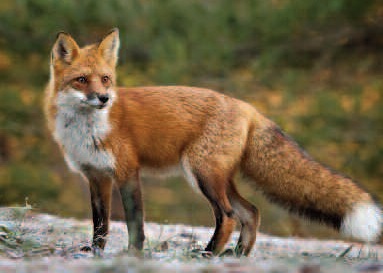A lean, mean hunting machine
by Roland D. Hallee
Last week, a friend of mine, who is a member of the Fairfield Police Department and an aspiring photographer, was telling me how he was out looking to snap photos of bald eagles when he came upon two of them devouring what was left of a red fox on the side of the road. His stealth attempt to retrieve his camera proved fruitless as the eagles sped off on their way. That would have been a really great photo.
You’ve probably read stories about the cunning fox trying to outwit his animal brothers and sisters. Foxes no doubt got their crafty reputation from the way they look, with their long, thin faces and yellow eyes that have narrow slits for pupils. But in real life, foxes are more concerned with finding food than with playing tricks on anyone.
The red fox, Vulpes vulpes, is a lean, mean hunting machine that’s built for speed. About 3-1/2 feet in length, slinky and long-legged, they only weigh about 10 pounds full grown. But red foxes look a lot bigger because of their thick fur, which can range from deep brownish red to sandy blonde with black legs, feet, and backs of the ears and white underparts. Sometimes red foxes can even be all black or black with white tips, or have a dark brown “cross” across their backs.

Red Fox, a sleek and efficient hunter.
Foxes are great hunters, and not only because they’re fast. Their large, upright ears allow them to locate a rustling sound within one degree of its true location, a trait that is not possible in humans. A fox can also hear a mouse squeal from 150 feet away.
Red foxes are solitary hunters that slowly approach their prey, creeping low to the ground and stretching their head high to spot the target. They pounce on the mouse, rabbit, or other prey with their forefeet.
Mice, especially meadow voles, are a popular food for red foxes, but their favorite dish is cottontail rabbit. They aren’t picky eaters either, and will eat berries and insects in the spring and summer, along with squirrels, songbirds, ducks and pheasants. In the north, they will also eat snowshoe rabbits, and they’ll even clean up after humans by eating garbage.
Nighttime is when red foxes are most active. They do most of their hunting from two hours before sunset to about four hours after sunrise, and travel up to nine miles a night. When they aren’t hunting, foxes like to rest in forests, ravines or woodlots, curling their long bushy tails around themselves to keep warm. The tail is also used for balance or as a signal flag to communicate with other foxes.
Fox families each have their own clearly marked home ranges that they defend from intruders, but they don’t usually fight. A group chase or a “threat display” – charging, growling, etc. – will generally do the trick. A fox family has a hunting range of about 150-400 acres, but in less diverse habitats, like farmland, one family might need up to 2-3 square miles.
Red fox don’t live in dens most of the year, but do set up nurseries in abandoned badger or woodchuck burrows when it’s time to have pups. Foxes breed in mid-January and have five or six pups in mid-March. The pups will hunt with their parents when they’re three months old and are ready to strike out on their own at eight months.
Red foxes can be found along fence rows, gravel roads, paths or treelines, especially after a light snowfall. Their tracks are very similar to that of a small dog. On spring or summer evenings, search along hillsides with binoculars. If you see a mound of fresh dirt in front of a dark hole, it could be a den entrance. But remember, be careful never to get too close and disturb the family. Remember, they are not fighters, but they are animals.
Once they have been discovered, they might pack up and move.
Treat red foxes with respect, and they could be a source of entertainment for you for quite some time.
Responsible journalism is hard work!
It is also expensive!
If you enjoy reading The Town Line and the good news we bring you each week, would you consider a donation to help us continue the work we’re doing?
The Town Line is a 501(c)(3) nonprofit private foundation, and all donations are tax deductible under the Internal Revenue Service code.
To help, please visit our online donation page or mail a check payable to The Town Line, PO Box 89, South China, ME 04358. Your contribution is appreciated!


Leave a Reply
Want to join the discussion?Feel free to contribute!